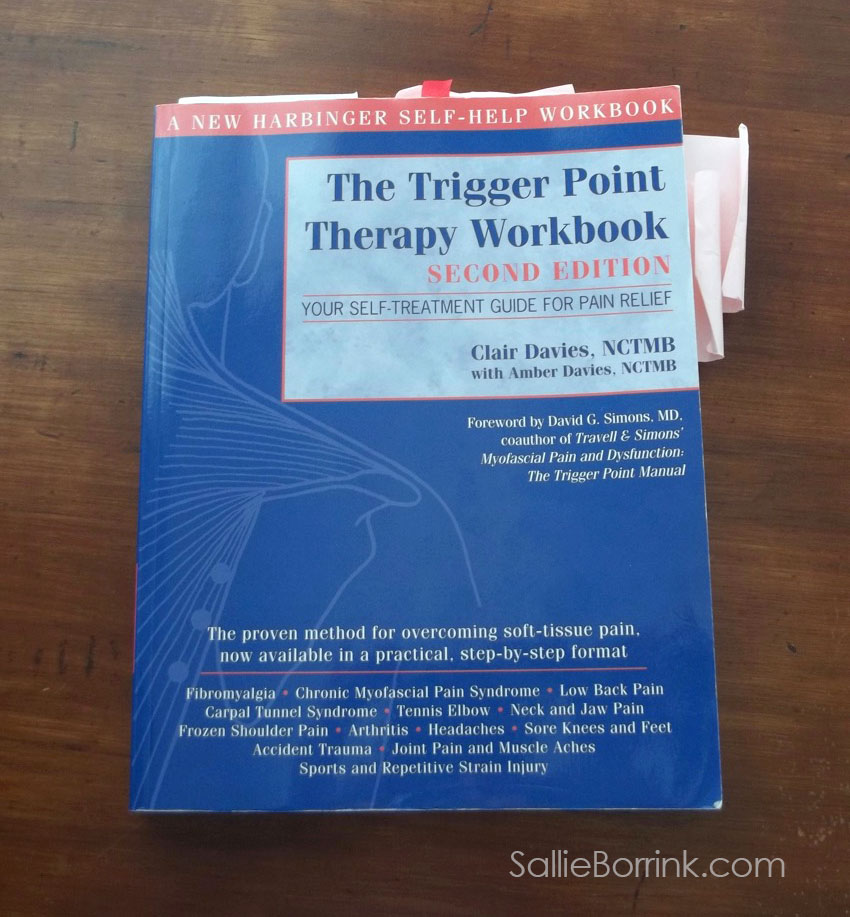Discovering trigger points therapy changed my life probably more than anything else I’m going to write about in my 5 Health Choices series. I say that because it unlocked my understanding of how the body works.
The Trigger Point Therapy Workbook is one of the most used books in our home. If we go out of town, it is on the packing list. It’s my go-to book. Understanding trigger points and having this book for a reference has saved us thousands of dollars in medical treatment over the years.
What are Trigger Points?
Trigger points are described this way in the book:
Travell and Simons describe a trigger point as simply a small contraction knot in muscle tissue. It often feels like a partly cooked piece of macaroni, or like a pea buried deep in the muscle. A trigger point affects a muscle by keeping it both tight and weak. At the same time, a trigger point maintains a hard contraction on the muscle fibers that it is a part of. In turn, these taut bands of muscle fiber keep constant tension on the muscle’s attachments, often producing symptoms in adjacent joints. The constant tension in the fibers of the trigger point itself restricts circulation in its immediate area. The resulting accumulation of the by-products of metabolism as well as deprivation of the oxygen and nutrients needed for metabolism, can perpetuate trigger points for months or even years unless some intervention occurs. It’s this self-sustaining vicious cycle that needs to be broken.
Although it sounds straightforward, it isn’t. The book explains:
The difficulty in treating trigger points is that they typically send pain to some other site. Most conventional treatment of pain is based on the assumption that the cause of pain will be found at the site of the pain. But trigger points almost always send their pain elsewhere. This referred pain is what has always thrown everybody off, including most doctors and much of the rest of the health-care community. According to Travell and Simons, conventional treatments for pain so often fail because they focus on the pain itself, treating the site of the pain while overlooking and failing to treat the cause, which may be some distance away.
Let me give you an example. You have a ache across your back where your bra strap goes. You feel like you need to crack and stretch your back. Guess what? The trigger point is not in your back. The trigger point is probably in your abdomen. What you are feeling is referred pain. You can get a back message and it won’t take care of the problem.
This is what makes trigger points so fascinating while also driving you a bit nuts in the process.
Difficulty Diagnosing My Problem
When I was going through my original health issues, I had so many weird symptoms and no one could figure out what was wrong with me. I had tests. I saw multiple doctors. I eventually ended up in the ER via ambulance because I was so sick. Like ERs do, they ran all the tests to tell me I wasn’t having a stroke or a heart attack and then they sent me home.
I was desperate to know what was wrong with me. I had a little girl who needed me. I couldn’t even pick her up. It was ruining my life.
After getting back from the ER, I got on my laptop and started searching out my weird combination of symptoms. And there in an obscure health discussion board in some dusty corner of the internet, I found the answer. I found my tiny little tribe of people who had the same problems and knew what was wrong with me.
It was my neck.
My neck. One of the few places on my body THAT DIDN’T HURT OR BOTHER ME.
My neck didn’t hurt. But my neck muscles were like concrete, riddled with trigger point problems, and it was sending a virtual tsunami of problems to numerous parts of my body.
Long story short, I ended up in physical therapy and that was the beginning of my journey to understanding trigger points.
Trigger Point Symptoms
Trigger points can cause symptoms that mimic so many other health issues it’s truly mind-boggling.
- appendicitis
- migraines
- angina
- lightheadedness
- restless leg syndrome
- sinus pain
- chest pain
- sleep problems
- tinnitus
- frozen shoulder
- eye pain
- leg cramps
- menstrual pain
- gum pain
- acid reflux
- TMJ
- chronic fatigue
- emphysema
- sensitive teeth
- dizziness
- bladder problems
- nausea
- lower back pain
- tooth pain
- shoulder pain
- breast pain
- arthritis
- carpal tunnel
- rapid heartbeat
- eye twitches
If I were in charge of the world, learning about trigger points would be required as part of a high school education. I can’t even begin to guess how much money this country could save in health care costs if people understood trigger points and were able to self-treat them.
How To Treat Trigger Points
I would be willing to guess that almost every person reading this has multiple trigger points in their body right now. Most people probably have a lot of them. Oftentimes trigger points are not painful until you push on them. Then they can be excruciating. You wonder how you walked around with that kind of dysfunction in your body and weren’t even aware it existed. But a few minutes under skilled hands can leave you breathless and in tears because those spots can hurt. A lot.
Obviously I have to say this – I’m not a doctor. Nothing I say here should be taken as medical advice. Don’t do anything health related without consulting your physician first. But I highly recommend looking into trigger points, perhaps starting with The Trigger Point Therapy Workbook. The best approach is to find a physical therapist who is skilled in trigger points who can evaluate you and teach you how to manage them. It could very well change your life.
Next up is another step I had to include in order to get the most from my trigger point work.

















 5 Health Choices That Changed My Life
5 Health Choices That Changed My Life
I have this same problem and didn’t know this was what was going on. I think God was using you to tell me this b/c right after I glanced at this post I went to my job at the library where this exact workbook had come up for me to shelve with the holds that patrons had requested. I don’t believe in coincidences. 🙂
Laura,
I don’t believe in coincidences either! That’s a great story. Thanks for sharing!